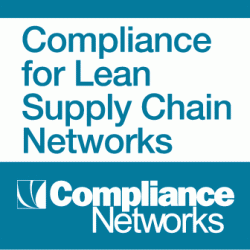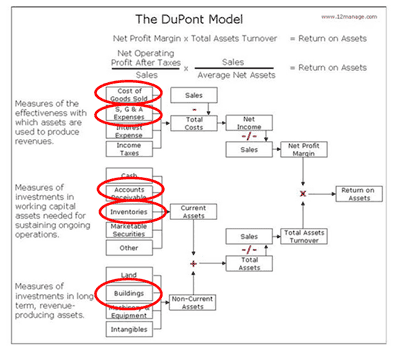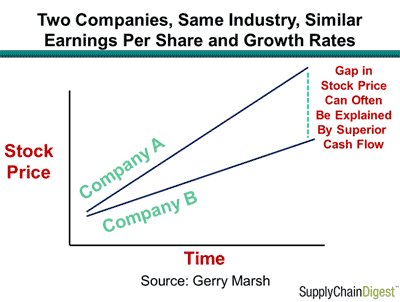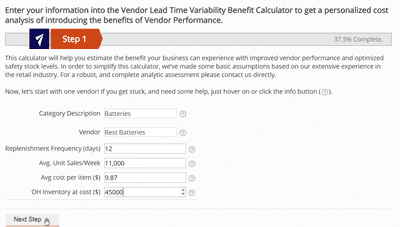 |
November 21, 2014 - Supply Chain Flagship Newsletter |
 |
| FEATURED SPONSOR: COMPLIANCE NETWORKS |
||
 |
||
FREE Calculator: Inbound Shipping Variability Impact on Expensive Safety Stock |
||
 |
|
||||||||||||||||||||||||||||||||||||||||||||||||||||||||||||||||||||||||||||||||||||||||||||||||
That left me a rather wide landscape to work with, didn't it? So, here I will describe what I wound up saying, which may actually be enough to stretch into two columns' worth. So, I began with just a sort of definition of supply chain, using the SCOR model that defines the meta process models of plan, source, make, deliver and (later) return some 20 years ago (with on-going revisions). The graphic I used illustrated that those core processes within a given company need to be designed and executed within the context of the plan, source, make, deliver and return processes of trading partners both up and down stream. Under the SCOR model graphic, I illustrated that all this happens within the three key flows of supply chains: materials, information, and cash. But I noted that the reality is that for most supply chain professionals, the cash part of it is really not much of a consideration, though that is changing a bit. I also noted that the need to tightly sync material and information flow is one of the reasons some supply chain software - notably WMS and MES - are often really challenging to implement, though I am not sure my audience well understood that point. Anyway, as you see below I noted how supply chain greatly impacts many of the key areas of the Dupont model, starting obviously with cost of goods sold, but also general overhead (where most distribution costs go) accounts receivable (supply chain issues can cause delayed payments), inventories, and "buildings," which are impacted by supply chain design and insource/outsource decisions). To the good or bad, if you can outsource a process that both reduces costs and allows you to get rid of assets (plants, DCs), that drives a lot of shareholder value, per the model. |
|||||||||||||||||||||||||||||||||||||||||||||||||||||||||||||||||||||||||||||||||||||||||||||||||
| I noted that this model was really important for both sides to understand, meaning for finance to better grasp the supply chain levers available to impact shareholder value, while these supply chain finance concepts are increasingly being taught to SCM professionals so they can better connect in theory and practice what they do to driving shareholder value. Then, as I have done here in the past, I summarized the work of Gerry Marsh, a California finance man who has worked with many of the greatest companies in the world. He has a proprietary but very compelling model for how increases in free cash flow - often derived from supply chain improvements that lead to inventory reductions - have a great and often not well understood impact on shareholder value. I have seen charts from him using real companies and results comparable to the generic example you see below, in which the difference in market capitalizations between two companies with the same basic earnings per share (EPS) and growth rates can be explained by differences in free cash flow generation. |
|||||||||||||||||||||||||||||||||||||||||||||||||||||||||||||||||||||||||||||||||||||||||||||||||
|
|||||||||||||||||||||||||||||||||||||||||||||||||||||||||||||||||||||||||||||||||||||||||||||||||
|
|||||||||||||||||||||||||||||||||||||||||||||||||||||||||||||||||||||||||||||||||||||||||||||||||
|
|||||||||||||||||||||||||||||||||||||||||||||||||||||||||||||||||||||||||||||||||||||||||||||||||
|
|
|
YOUR FEEDBACK
Catching up with some feedback from some First Thoughts columns over the past few weeks.
That includes an outstanding email that's our Feedback of the Week on our First Thought column on The Coming US Logistics Cost Crack-Up? from long-time transportation sector executive David Goodson.
It is detailed and long enough we will just let it stand on its own - good insight.
Feedback on Logistics Cost Crack-Up:
While I have no doubt logistics costs are going up, a 22 percent increase is doubtful. Any significant price increase will force shippers to change practices to help carrier mitigate cost increases. Also, if rates go up substantially, expect more capacity to enter the market to bring supply and demand in line. However, it takes 1-2 years for additional capacity to come into the market, so there could be some eye-popping rate increases in the short term, which will recede over time. Electronic logging will have a much bigger impact that 2%. (I really don't know how any trucking company could detect a 2% change in productivity due to single factor.) Paper logging has always been the fudge factor that mitigates the loss in productivity of new regulations.
David Goodson
|
||
SUPPLY CHAIN TRIVIA ANSWER
Q: Please match the following EDI transaction types to its ANSI transaction number: ASN, Purchase Order, Shipment Status, Load Tender, and Invoice against 204, 214, 810, 850 and 856.
A: ASN - 856, Purchase Order - 850, Shipment Status - 214, Load Tender - 204, and Invoice - 810 .
| © SupplyChainDigest™ 2003-2014. All Rights Reserved. SupplyChainDigest PO Box 714 Springboro, Ohio 45066 |
POWERED BY: XDIMENSION
|










